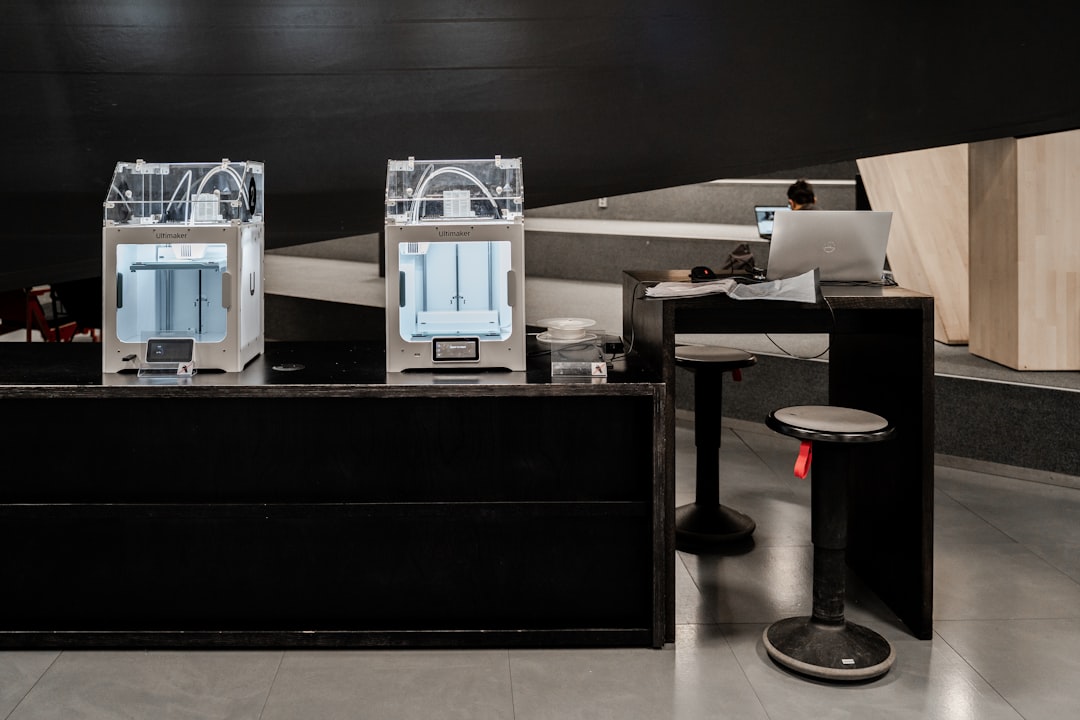

Engage prospects with a scan and streamline customer engagement with FREE QR code marketing tools by Sona – no strings attached!
Create a Free QR CodeFree consultation

No commitment

Engage prospects with a scan and streamline customer engagement with FREE QR code marketing tools by Sona – no strings attached!
Create a Free QR CodeFree consultation

No commitment
QR codes have become an essential tool for bridging the gap between physical equipment and digital workflows in today’s digitally driven world. For fingerprinting equipment suppliers, QR codes provide a seamless, secure, and scalable means to streamline customer access, enhance equipment management, and boost operational efficiency.
Embedding QR codes on live scan fingerprinting systems, packaging, service contracts, or signage enables instant registration, product authentication, and access to equipment manuals or background check submissions. This connectivity transforms outdated analog touchpoints like manual sign-ins and paper instructions into automated, insight-rich digital journeys, especially when paired with digital signage.
Fingerprinting equipment suppliers often deal with missed follow-ups, limited visibility into system access, and friction in compliance or support requests. Tailored QR code solutions simplify access, enrich data capture, surface important engagement signals, and strengthen compliance and device security, ultimately driving better outcomes for enterprise and security-focused clients.

Fingerprinting equipment suppliers frequently struggle with manual workflows and limited insight into who uses their hardware, leading to lost onboarding opportunities and inefficient support. QR codes eliminate paper chokepoints, connect field hardware to cloud systems, and enable policy-compliant access for both staff and end customers. When properly designed, they reduce onboarding time, improve data integrity, and give teams visibility into the full lifecycle of a device.
Start by identifying analog processes that drain time or introduce errors. Examples include printed user manuals that quickly become outdated, clipboard sign-in sheets for device access, and email back-and-forth for service scheduling. Replace each with a scannable workflow that authenticates the user, records the action, and delivers the exact resource needed. Using a platform like Sona QR, you can make each scan trackable, editable, and attributable, so your team can see what is working in real time and iterate. Start creating QR codes for free.
Applying these steps allows fingerprinting equipment suppliers to modernize workflows, surface engagement signals, and provide customers with a frictionless and secure digital experience. The result is a tighter connection between the physical machine and the digital systems that govern training, compliance, and support.

Operational blind spots and data fragmentation can undermine customer experience and introduce compliance risk for fingerprinting equipment suppliers. QR codes solve for both by transforming passive, printed touchpoints into active gateways that authenticate users, deliver tailored content, and capture analytics. In regulated and security-sensitive environments, that means fewer manual errors and stronger traceability.
Consider the practical implications in daily operations. Technicians working in field locations need quick access to device setup guides, calibration procedures, and audit checklists that may change as standards evolve. End customers require a simple way to register devices, submit background checks, or request maintenance without calling support. QR codes put all of this one scan away, while giving suppliers the data they need to improve documentation, prioritize updates, and forecast demand.
By closing workflow and data gaps, QR codes give fingerprinting equipment suppliers measurable ways to improve operational resilience and customer satisfaction. Teams can maintain compliance-ready documentation, ensure consistent onboarding, and pinpoint where to invest in training or product improvements.

Fingerprinting equipment suppliers can utilize distinct QR code formats to address operational and customer challenges across the device lifecycle. Choosing the right format ensures the destination matches the user’s intent at the point of scan.
Dynamic codes are especially valuable in this vertical. They deliver analytics, support A/B testing of destinations, and allow post-deployment edits when documentation or regulations change. Static codes still play a role for fixed assets like a permanent facility map or a safety poster, but dynamic links should be considered the default for equipment and customer-facing workflows.

Many suppliers miss opportunities at high-intent physical touchpoints where a scan could convert interest into action. Mapping all the places your buyers and operators interact with devices and documentation helps identify where QR codes can lift engagement, reduce service load, and grow revenue.
Placement should be strategic. Codes must be visible without obstructing operation, durable under cleaning agents, and scannable in varied lighting. Pair each with a clear, benefit-driven CTA that aligns with the situational need. For example, a code near the platen might say Scan for sanitization protocol, while the code on the back panel might read Scan for technical service.
Strategic placements maximize convenience and generate segmented data for retargeting. When you tag codes by channel and content, you create a live map of who is engaging and where to invest to close deals faster.
QR codes are most powerful when they tie a real-world action to a specific outcome that matters to your business and your customers. The following use cases are designed for the realities of fingerprinting hardware, compliance, and enterprise support.
Each use case should be tied to a measurable outcome such as reduced onboarding time, higher first-time capture quality, or increased contract renewals. With dynamic QR codes, you can test different content or formats and optimize toward those goals.
Each QR code scan is a signal. It indicates who engaged, what they needed, and when they were most receptive. By deploying multiple codes across touchpoints and mapping them to journey stages, suppliers can create segmented audiences for precise retargeting and smarter follow-up.
Start by assigning codes to the stages you care about most. For example, use awareness codes on trade show signage that link to a product overview, consideration codes on brochures that link to detailed spec sheets, and conversion codes on pricing sheets that request a quote. Each scan adds the individual or account to a stage-specific list with clear intent.
With Sona QR, each code becomes a smart entry point into your funnel. You can automatically segment by channel and context, then retarget based on real behavior rather than assumptions. For fingerprinting equipment suppliers, meaningful distinctions include law enforcement agencies versus private security firms, enterprise HR teams versus small staffing agencies, and operations managers versus IT administrators.
QR codes create a continuous data thread across every offline and digital channel. Used consistently, they knit together field activity, events, print campaigns, and your website into a single, measurable customer journey. This is especially important for hardware suppliers whose buyers often begin offline; see Sona’s blog post titled The Essential Guide to Offline Attribution.
Begin by aligning QR destinations with the content strategy for each channel. At events, your audience may prefer top-of-funnel demos, while in installation kits they need mid-funnel configuration guides. Direct mail might focus on renewals or trade-in offers. Make every scan earn its place by delivering immediate, high-value next steps.
QR codes serve as the offline onramp to your digital marketing engine. With a centralized platform like Sona QR, you can manage all codes, monitor performance by placement, and sync scan data with your CRM and ad tools. This closes the loop between field activity and pipeline development.
Running a structured QR campaign keeps teams aligned and makes outcomes predictable. The following checklist outlines the essential steps fingerprinting equipment suppliers should take, from planning through optimization.
Clarify the job your QR code needs to do. Common goals include rapid onboarding at recruiting events, device activation in the field, service scheduling, or collecting audit confirmations. The more specific the goal, the easier it will be to design the destination and measure success.
Align the use case with a business outcome such as faster time to first scan after delivery, higher renewal rates for maintenance plans, or reduced support call volume. For example, during a law enforcement conference, your objective might be to drive qualified demo requests for new live scan models and to attribute those requests to the event.
Select static codes for content that will never change, such as a facility map. Choose dynamic codes for anything campaign-related or compliance-sensitive. Dynamic codes enable tracking, allow destination edits without reprinting, and support testing different content for different audiences.
Match the format to the user action. Use web links for activation portals and training hubs, SMS or email formats for service requests, and vCards for escalation contacts. For mobile apps that pair with devices, use app download formats that detect the user’s OS and route accordingly.
Incorporate your logo and brand colors, but prioritize contrast and quiet zone spacing for reliable scanning. Add a clear, benefit-oriented CTA adjacent to the code, such as Scan to activate, Scan for compliance checklist, or Scan to book service. Consider adding a short URL as a fallback for users who cannot scan.
Test codes in the actual environments where they will live. Validate in different lighting, at different angles, and on varied materials like metal panels, laminated cards, and corrugated packaging. Confirm performance with both iOS and Android default camera apps and ensure the landing page is mobile optimized.
Place codes where they naturally align with behavior. For hardware, that means faceplates, back panels, and service doors. For customer communications, include codes in direct mailers, onboarding inserts, and trade show materials. Ensure durable labels and protective laminates for high-touch areas.
Tag each deployment by channel and location for clean attribution. For instance, label codes Event-ISC-West-2025-Demo, Equipment-LS400-BackPanel, and Mailer-Q3-Upgrade-Offer. This taxonomy turns every scan into a structured data point you can compare across campaigns.
Monitor scans by time, device, and location. Tie scans to conversions like account creation, content downloads, or booked service. If drop-off occurs on a landing page, test shorter forms, clearer copy, or richer content. If a code underperforms due to placement, experiment with size, contrast, or relocation. For CRM sync, see Sona’s blog post titled Integrate Sona with HubSpot CRM.
Feed insights back into your planning. Double down on channels with strong conversion rates and retire codes that do not move the needle. With Sona QR, you can view performance dashboards, run A/B tests, and push winning experiences to all relevant deployments without reprinting.
Following this checklist supports a cycle of continuous improvement and reveals where QR-driven interactions are creating real revenue impact.
Attribution gaps can disconnect physical engagement from business outcomes, especially when a buyer’s journey begins on a device or a printed brochure. QR codes close that gap by making offline interactions measurable and by linking scans to downstream actions such as demo requests, training completions, and purchase orders.
To extract value, you need to measure beyond the scan. That means capturing the device or campaign source, identifying the user or account when possible, and mapping the next steps they take. Over time, you will see which placements drive activations, which training assets reduce support volume, and which event scans correlate with pipeline and renewals. Read Sona’s blog post titled The Essential Guide to Account Identification.
With Sona QR and Sona.com, you can track every scan with time, device, and location, measure engagement by channel, respond in real time, and tie outcomes to revenue via identity resolution and multi-touch attribution. Sona’s Buyer Journeys unify fragmented touchpoints, connecting QR scans to website visits, ad clicks, and CRM milestones so you can see how physical engagement contributes to pipeline and closed-won deals.
QR code programs grow strongest when they are woven into daily operations and supported by automation. The following practices help you scale efficiently and maintain clean attribution while improving user experience.
Start with specificity. Assign one QR code per asset or campaign and append UTM parameters to distinguish traffic by source and medium. Then, automate the next step for the user so that every scan moves them forward without manual intervention. Finally, train staff to explain the benefit of scanning and to check that codes are visible and scannable.
A creative tactic for this vertical is issuing QR-coded technician ID cards that open a secure access portal when scanned. This both validates the tech on site and logs service activity with timestamps, generating an auditable trail while streamlining entry to documentation.

The most convincing arguments for QR adoption come from measurable wins in the field. Suppliers that thoughtfully deploy codes at the right moments consistently report faster onboarding, cleaner audits, and stronger engagement.
Creative placements often outperform expectations. For example, placing a QR code inside the hinged service door that opens to a maintenance checklist ensures technicians see it exactly when needed. A laminated, wipe-resistant sticker near the platen guiding to a cleaning tutorial reduces smudges and retakes, which improves throughput and user satisfaction.
Success with QR codes in a regulated, high-stakes environment depends on reliability, security, and context. Focus on scannability, use dynamic codes for flexibility, and avoid placements that are hard to reach or likely to glare under overhead lighting.
Staff training is paramount. Operators and technicians should know what each code does, when to scan it, and what to expect next. When possible, connect scan events with user identity so you can personalize experiences and build a complete engagement picture at the account level.
QR codes empower fingerprinting equipment suppliers to transform every physical interaction, from live scan device activation to compliance paperwork submission, into an opportunity for data capture, targeted engagement, and actionable insight. This counteracts longstanding challenges like missed leads, untracked device access, and fragmented onboarding, aligning marketing and support with real user activity.
Embedding QR workflows across equipment, documentation, and outreach materials offers suppliers unprecedented visibility into user behavior and lead quality while streamlining processes for end users. The result is improved operational efficiency, stronger compliance, and a future-ready, data-driven business model that adapts to evolving regulatory and customer demands.
QR codes have revolutionized the fingerprinting equipment suppliers industry by turning traditional product interactions into dynamic, measurable engagement opportunities. From streamlining equipment access and authentication to enhancing client onboarding and support, QR codes enable suppliers to deliver seamless experiences while capturing valuable data that drives smarter business decisions. Imagine instantly verifying equipment authenticity or providing step-by-step usage guides with a simple scan—empowering both suppliers and customers like never before.
With Sona QR, you can effortlessly create dynamic, trackable QR codes that update in real time without the need to reprint labels or manuals. Every scan connects directly to actionable insights, helping you optimize inventory management, improve customer satisfaction, and accelerate sales cycles. Start for free with Sona QR today and transform every scan into a secure, efficient, and profitable interaction within your fingerprinting equipment supply chain.
QR codes enable seamless, secure access, streamline workflows, provide real-time data capture, improve compliance, and enhance customer experience by connecting physical devices to digital systems.
Suppliers can replace manual processes with scannable workflows for registration, training, maintenance logging, and background check submissions, reducing onboarding time and support tickets.
Useful formats include web links for activation portals, vCards for support contacts, SMS or email codes for service requests, Wi-Fi access codes, and app download links tailored to user devices.
Codes should be placed on device faceplates, rear panels, service doors, packaging inserts, trade show materials, and direct mail to align with user behavior and ensure visibility and durability.
Dynamic QR codes allow destination updates without reprinting, enable tracking, support A/B testing, and provide analytics to optimize content and measure engagement effectively.
Success can be measured by tracking scan metadata, onboarding time, self-service rates, support resolution times, and linking scans to conversions like account creation and training completion.
Challenges include poor placement, glare, and lack of staff training; they can be addressed by testing codes in real environments, using branded dynamic codes, and educating users on scanning benefits.
QR codes provide traceable, authenticated access to updated manuals, checklists, and audit logs, reducing manual errors and supporting CJIS-aligned security requirements.
QR codes streamline onboarding by linking to secure portals for device registration and guide applicants through consent, identity verification, and appointment scheduling, improving completeness and throughput.
Suppliers can use QR codes on brochures, trade show displays, direct mail, and digital signage to capture leads, track engagement by channel, and sync data with CRM systems for targeted follow-up.
Design codes with high contrast, clear CTAs, test in real settings, use durable materials, assign unique codes per asset, tag by channel, and deploy across touchpoints aligned with user workflows.
QR codes enable quick access to troubleshooting guides, calibration procedures, and service logging forms, which reduce support calls, improve first-contact resolution, and document maintenance history.
QR codes reduce print costs, manual processing, and phone support by consolidating manuals, firmware updates, and service notices into a single, updateable digital resource.
The article does not provide a specific list of DOJ approved live scan machines but suggests suppliers should refer to official regulatory resources or vendor certifications for approved equipment.
The article does not specify costs for live scan fingerprinting equipment.
Choose equipment that supports secure, CJIS-compliant workflows, integrates with digital tools like QR codes for onboarding and maintenance, offers dynamic content updates, and fits your operational needs.
Look for secure access controls, compatibility with digital workflows via QR codes, ease of maintenance tracking, dynamic content support, and compliance with regulatory standards like CJIS.
The article does not list specific top fingerprinting equipment suppliers.
Use Sona QR's trackable codes to improve customer acquisition and engagement today.
Create Your FREE Trackable QR Code in SecondsJoin results-focused teams combining Sona Platform automation with advanced Google Ads strategies to scale lead generation

Connect your existing CRM

Free Account Enrichment

No setup fees
No commitment required

Free consultation

Get a custom Google Ads roadmap for your business






Launch campaigns that generate qualified leads in 30 days or less.
